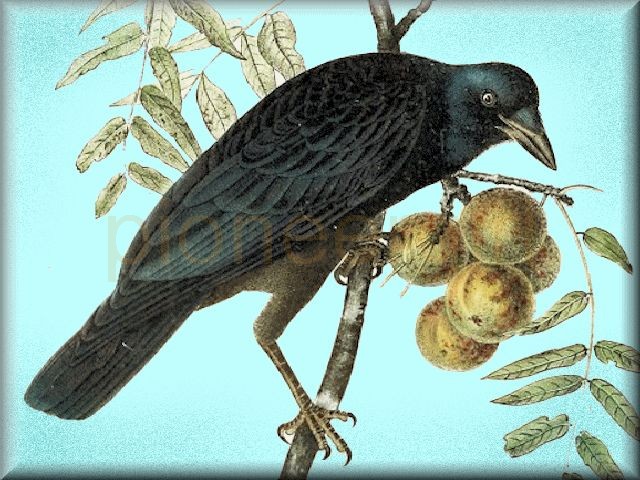crow

A large bird, usually black, of the genus Corcus, having a conical and somewhat curved beak, with projecting plumes at its base, and uttering a harsh, croaking note. The common American crow is C. Americanus. — Webster, 1882
 While Laura Ingalls Wilder mentions that blackbirds destroy the crops in Little Town on the Prairie, she also introduces crows into the picture when she has Grace and Pa chant the planting rhyme: “One for the blackbird, one for the crow, and that will leave just two to grow.”
While Laura Ingalls Wilder mentions that blackbirds destroy the crops in Little Town on the Prairie, she also introduces crows into the picture when she has Grace and Pa chant the planting rhyme: “One for the blackbird, one for the crow, and that will leave just two to grow.”
Were there also crows in De Smet? Certainly. Did they also get into the corn and oats? Surely. Did the Ingalls family eat crow as well as blackbird? Hmmmm?
The American crow is Corvus brachyrhynchos. The crow family, Corvidae, includes jays, nutcrackers, magpies, jackdaws, rooks, choughs, ravens and (of course) crows. The genus Corvus includes both crows and ravens.
I had always heard that people don’t eat crow, that you just plain don’t eat animals that chow down on carrion – in addition to everything else on the planet from soup to nuts. Then again, pointed out by many I talked to, that we eat things like pigs and blue crab, and pigs eat almost everything and crab are bottom feeders, for Pete’s sake. There are lots of stories about the source of the saying, “Eating crow,” and not one of them is positive.
An article published in the Atlanta Constitution in 1888 claims that, towards the end of the war of 1812, an American soldier went hunting and by accident crossed behind British lines, where he shot a crow. He was caught by a British officer, who, complimenting him on his fine shooting, persuaded him to hand over his gun. This officer then levelled his gun and said that as a punishment the American must take a bite of the crow. The American obeyed, but when the British officer returned his gun he took his revenge by making him eat the rest of the bird. This is such an inventive novelisation of the phrase’s etymology that it seems a shame to point out that the original expression is not recorded until the 1850s, and that its original form was to eat boiled crow, whereas the story makes no mention of boiling the bird.
Crows are much smarter birds than blackbirds. Crows are territorial and post guards to warn other crows of danger. They can quickly learn the difference between, say, Pa with a gun and Pa with a hoe in his hand, and will flee from one while not bothering the other. (If it had been crows in the corn, would they have flown from Ma and the girls swinging their sunbonnets if they had also been carrying guns?) They are nusiance birds and can destroy crops in a hurry. They will learn that your melon patch is closer than the nearest source of water, so they’ll drink your fruit juice rather than waste the time and effort to fly a bit farther for water. Crows will crack other eggs and can affect the numbers of water fowl in an area. They even have been known to attack small sheep or other farm animals.
Crow is now a protected species, and the hunting of crows is limited — there is a crow hunting season. Although mostly hunted to reduce the crow population, there are many who believe that crow is as dainty a dish as blackbird. The meat harvested is usually the two small pieces of breast meat only, each the size of a small lime. Perhaps Ma made fried crow on occasion; I don’t know, and Laura never told us. To fry crow, dip meat in beaten egg, then flour. Fry in hot oil. Drop me an email and let me know how it tastes, would you?

crow (LHP 14, 25)
“black as a crow” (LHP 24)
“one for the blackbird, one for the crow” (LTP 2-3)
“whistling girls and crowing hens…” (FB 11)

